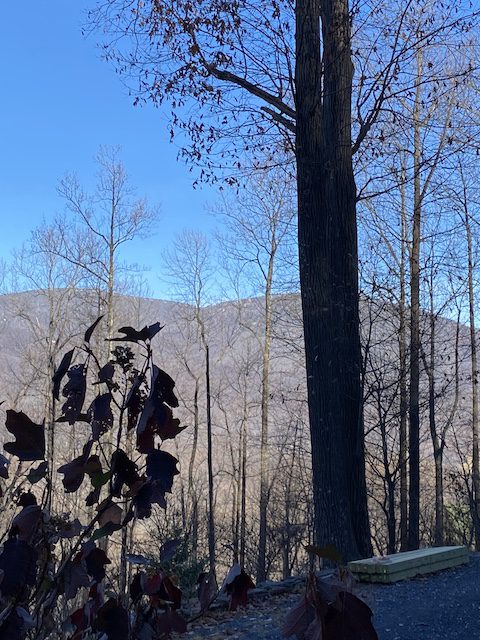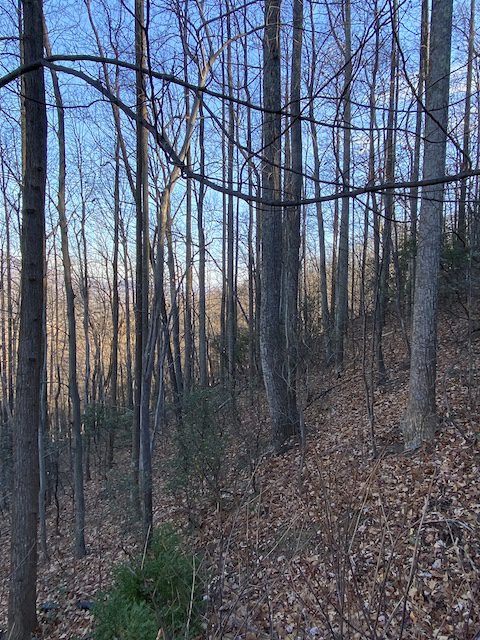


Here in the third season at Vanaprastha, the deciduous trees have dropped their leaves. Now that the winds have stilled, I will blow the debris from ditches and culverts along the road. It’s a task I enjoy, participating in the cycle of life.
I cannot remember a time when I didn’t look upon trees as special creations. Indeed, according to Harriet Nix in The Genius of Trees, trees alter the air, shape soil and the flow of water, use fire as a tool, and build relationships with fungi, plants, animals, and humans around them. As a believer, I see the hand of God in all of this.
Trees and Wind
When friends visit our mountain home, they admire the views while expressing concern about the tall trees near the houseand wind. Curious about the relationship between wind and trees, I did a little research. The number one adjective for wind is “damaging,” and there’s a lot of empirical proof for that. Wind limits tree growth. Wind knocks down and uproots trees, what’s known as wind-throw. Wind damages plant cells through wind-blown sand.
In his article How Wind Affects Trees, William R. Chaney, Professor of Tree Physiology in the Department of Forestry and Natural Resources at Purdue University, wrote, “Wind in trees does more than rustle leaves. The gentle breezes, prevailing winds, and cyclonic occurrences that arise from daily and seasonal changes in solar heating all affect the growth, form, and very survival of trees.” As with wind, as with people, and that is good news.
Winds help with seed dispersal, pollination, and distribution of life-sustaining moisture—and more. Trees can be strengthened by wind to withstand stronger winds, and cells damaged by wind-blown sand can become stronger for their reparative efforts. To adjust the metaphor, people are trees buffeted and shaped by the winds of life and are strengthened as they withstand and adapt. Like the tall trees of Vanaprastha, people who face the wind are better for it.
Trees and Knots
“I’d like to be a tree,” said actress Katharine Hepburn during her 1981 interview on the TV program 20/20. “What kind of tree?” host Barbara Walters asked as a follow up. “An oak because they are strong and pretty.” She didn’t mention that oak tree leaves and acorns are toxic to most livestock due to large amounts of tannic acid. They also tend to suck up water and sun, thus killing off much that might try to grow underneath.
Perhaps an oak tree provides a good metaphor for the competitive world of Hollywood. Hepburn was outspoken, at times demanding and acerbic. She said careers and marriage don’t mix, and children were out of the question. “I would have been a terrible mother,” she’s been quoted as saying, “because I’m basically a very selfish human being.” She was indeed a knotty soul.
Tree knots are common lumps or holes within the trunk caused, for the most part, by natural growth. As a tree grows, the trunk expands and overtakes branches. Knots of tough wood form tightly around attached branches and overgrow pruned branches, or those that fall off. If branches become damaged or die while still attached, loose knots form with a dark plug of dead or decaying wood in the center, which open the tree to fungal infection.
I think knots are one of the most distinctive parts of a tree because they show growth and vulnerability, the ability to embrace change and overcome adversity. And knots are strong, stronger than the tree itself.
Trees and Fruit
That person is like a tree planted by streams of water, which yields its fruit in season and whose leaf does not wither—whatever they do prospers. Psalm 1:3 NIV
It wasn’t until I traversed Michelle Van Loon’s first-half-of-life spiritual growth stages, as defined in Becoming Sage: Cultivating Meaning, Purpose, and Spirituality in Midlife—“God, I believe in You,” “God, I belong to You,” and “God, I’m working for You,”—that I discovered my third-stage-of-life avenue to fruitful living. His purpose, not mine. Or as Paul stated in 2 Timothy 1:9, He has saved us and called us to a holy life—not because of anything we have done but because of his own purpose and grace. This grace was given us in Christ Jesus before the beginning of time.
I think the greatest blessing during the third stage of life is to become a grandparent, as I have. Even if you don’t have grandchildren, you can be a grandparent to children. Grandparents are elders, uniquely positioned to mentor, encourage, support, and guide those in the first stage of life while their parents pursue second-stage endeavors. Rather than sages on the stage, grandparents are guides on the side, passing their wisdom on to the younger generation.
Wind-blown, knotty trees bearing fruit, maturing in faith and encouraging others. I can’t think of a better life purpose than being that kind of tree, can you?



0 Comments